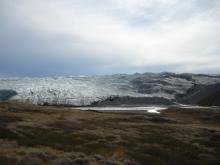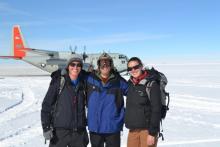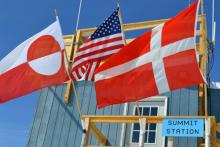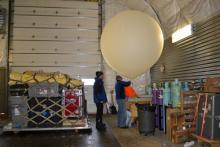Update
All PolarConnect Events Kevin and his team are available here: PolarConnect Event Archives!
This is the second trip for Kevin to Greenland! He accompanied Mike Bergin on an expedition to Summit in 2006. You can read about that expedition here.
What Are They Doing?
Aerosols are small, solid, particles like dust, smoke, and smog which are suspended in the air. Aerosols are generated by a variety of natural and man-made sources such as fossil fuel combustion, forest fires, and dust storms. Because aerosols have the ability to diffuse light coming from the sun, they may actually have a cooling impact on our Earth’s climate and the Greenland Ice Sheet.
In order to study the effect of aerosols on the arctic and the Greenland Ice Sheet, the research team took snow and air samples to measure the amount of aerosols. By looking at snow surface properties and chemistry the research team explored connections between aerosols and the snow surface albedo, or reflectivity.
The Greenland Ice Sheet plays a key role in regulating global climate. It also stores a large volume of fresh water. If it melts, it has the potential to cause sea level to rise. It is important to understand how air pollutants impact the climate of the Arctic, because changes in the Greenland Ice Sheet could affect places and people around the world. Better understanding the effects of aerosols would allow us to predict or adapt to some of these changes.
Where Are They?
The team lived and worked at Summit Station, located at the peak of the Greenland ice cap atop 3216 meters (10,551 ft) of ice. Summit is a scientific research station sponsored by the National Science Foundation that supports a diversity of scientific research, including year-round measurements of air-snow interactions that provide crucial knowledge for interpreting data from deep ice cores drilled both at Summit and elsewhere. During the summer months the camp is accessed via Kangerlussuaq, a small community located on the west coast of Greenland.
Latest Journals

Mike Bergin is a professor in the School of Civil and Environmental Engineering at Georgia Institute of Technology. His research interests include the processes that emit, transform and deposit particulate matter. He has travelled all over the world for his research, including Greenland, China, France, and Nepal.

I grew up in a house, unlike my minimalist advisor, Mike, who was raised by a pack of feral wolves and only learned basic arithmetic as a teenager, but I do enjoy the outdoors. When I'm not saving the world one aerosol at a time, I enjoy baking and walking from one place to another.





